Mushrooms: How to Offer Mushrooms Safely to Babies
- Portobello strips - you can grill a portobello, I like to lather it in olive oil and then add balsamic vinegar, get it nice & soft and cut into strips and make sure it passes the squish test before offering to your baby.
- The blend trend - finely chopped mushrooms combine half and half with your favorite ground meat like beef or bison or turkey or chicken. You can put this in burgers or tacos or anywhere else you would use ground meat, but filled halfway with mushrooms.
- Sautee - particularly like enoki, beech and maitake & royal trumpet mushrooms - these are longer sizes babies can pick up. They have a handle for a stem and go great in some butter or olive oil.
- Risotto - mushrooms go great in risotto, you can make with any short grain rice such as sushi rice (calrose rice) or the traditional way, with arborio. Also any gratin with a whole grain you can always add mushrooms too as well.
- Omelets - egg cups or omelets with mushrooms work great for BLW. Eggs are a potentially allergenic food so you want to make sure baby has had egg a number of times without reaction before trying this.
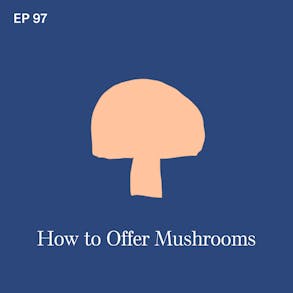
LISTEN TO THIS EPISODE
Episode Description
Babies can eat so many more foods than we give them credit for...like mushrooms! Mushrooms are one of those foods that adults love to hate, but babies...babies will eat anything, including mushrooms! In this episode we’ll take a look at how to feed mushrooms safely to your baby for baby-led weaning.
Mushrooms are a surprising source of nutrition, not to mention a unique taste and texture experience for your baby. In this episode I’m sharing a number of ways to prepare mushrooms and mushroom recipes that work well for baby-led weaning.
Links from this Episode
- Baby-Led Weaning with Katie Ferraro program with the 100 First Foods™ Daily Meal Plan, join here: https://babyledweaning.co/program
- Baby-Led Weaning for Beginners free online workshop with 100 First Foods™ list to all attendees, register here: https://babyledweaning.co/baby-led-weaning-for-beginners
.
Other Episodes Related to this Topic

Latest Episodes

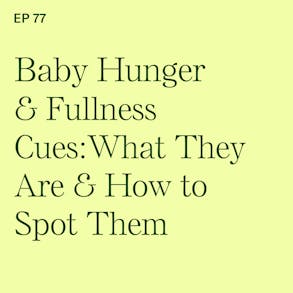
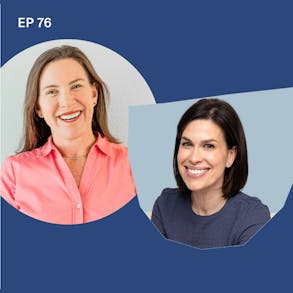
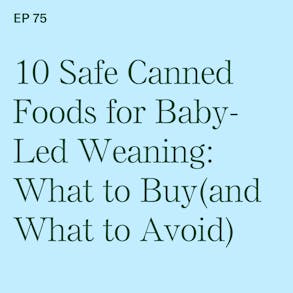
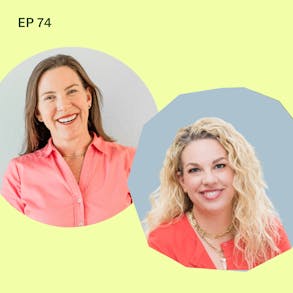
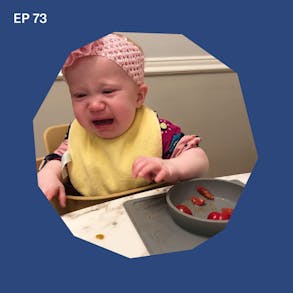
Katie Ferraro (0s):
So from a nutrition standpoint, mushrooms are really amazing, especially with regard to vitamin D. They've also got that umami flavor and the really unique rubbery textures, babies love mushrooms, and there's lots of ways you can make the mushroom safe to offer to your baby. Hey, there I'm Katie Ferraro, registered dietician, college nutrition professor, and mom of seven specializing in baby-led weaning here on the Baby-Led Weaning Made Easy podcast. I help you strip out all of the noise and nonsense about feeding, leaving you with the competence and knowledge you need to give your baby a safe start to solid foods using baby-led weaning.
Katie Ferraro (42s):
Well, hello, welcome back. Today, we are talking about mushrooms and I know people feel passionately about mushrooms. They either like really love them or seriously despise them. And I feel like children in particular are notorious for disliking mushrooms. But babies, babies will eat anything and especially if you could catch them during what I like to call the honeymoon feeding phase. That's the period when your baby is between six and about 15, sometimes even 18 months of age. And they'll like, and accept almost all foods. Well, if you introduce mushrooms early and often, and you get them in your rotation, you could very well have a mushroom lover on your hands for the rest of your life. Now I love to start these mini baby-led weaning training episodes with a baby-led weaning tip of the day.
Katie Ferraro (1m 22s):
Today's is more of a fun fact than a tip, but mushrooms, if you did not know, they're the only non animal unfortified substantial source of vitamin D in the diet. There's not a lot of places to get vitamin D and you guys probably have heard it's the sunshine vitamin right? Vitamin D helps our bones and our baby's bones absorb calcium, but all the calcium in the world doesn't matter if you don't have vitamin D to help the bones absorb it. But it's really hard to find naturally occurring. It's in very few foods and certainly not in many plant foods or hardly any except for mushrooms. And then oftentimes we have to find it in fortified foods. So mostly we get vitamin D from fortified dairy products, which is great if you include those regularly in your diet, but it's not bad to have a few sources of vitamin D.
Katie Ferraro (2m 2s):
So fatty fish like cod liver oil, for example, is a good source of vitamin D fortified dairy products, but certain types of mushrooms are high in vitamin D. And I'll talk about that today. I'm actually gonna be sharing a little bit about a lot of different types of mushrooms and how we can make them safe for babies to eat. So let's dive in, looking at mushrooms and how to offer mushrooms safely to babies. Now, there are all sorts of mushrooms out there. They're fresh ones. There's frozen ones, canned and dried. When it comes to fresh mushrooms, we generally don't feed raw vegetables to babies, especially raw mushrooms. Just think about your typical white button mushroom that you might find at a grocery store. They can be very dry and very mealy, which in turn can be a choking hazard. I know personally, I don't love dry mushrooms or raw mushrooms, but you cook that mushroom.
Katie Ferraro (2m 43s):
It becomes like a totally different food. I'm like, how did this delicious cooked mushroom come from that gross, dry, raw mushroom. But when you cook mushrooms, I think it improves the flavor. That's a personal assessment, but it helps develop a meaty flavor it's referred to as umami and the soft mushrooms. When you've them, not only does it develop a more intense flavor, which is more pleasurable on the palette, but it's also safer for the baby to eat when the mushroom is cooked. So we want to stick to cook mushrooms. When we're talking about feeding raw versus cooked, stick to cooked. Now, what about, can you certainly can buy no added salt versions of canned mushrooms are a little bit harder to find. They don't necessarily have as much flavor, but they work in a pinch. Frozen mushrooms are also an option.
Katie Ferraro (3m 24s):
It's not one of like the most popular, frozen vegetables that you're likely to see throughout every type of grocery store, but you certainly can find frozen mushrooms if you're unable to get them raw or canned, and then dried mushrooms are an option as well. If you reconstitute them with hot water, you let them steep in the hot water, which then allows the mushrooms. The dried wants to become soft and plump provided that they're not chewy. It can be totally safe to feed your baby dried mushrooms or as an ingredient in other foods as well. There's lots of different varieties of mushrooms. I think if you think of the typical you're run of the mill grocery store, you're going to see button mushrooms. Portabello does sometimes cremini mushrooms, but there's many, many other varieties. They love oyster mushrooms, enoki, royal trumpet, lots of great options out there.
Katie Ferraro (4m 7s):
Some of which are actually a little bit better for baby-led weaning. If you'd look at them some of the more, I guess you may think of them as the exotic varieties, which aren't perhaps as ubiquitous at your typical grocery store, but particularly if you're shopping at an Asian grocery stores, you can find a lot of different varieties that have like a longer handle, essentially. So the mushroom the buttons on the top with a longer handle, that when you cook it, the baby can scoop it up and feed it to themselves. Might work better for baby-led and weeding than like your traditional short button mushroom, which can, can be kind of hard for babies to pick up. Now, what about wild mushrooms? Of course, there are lots of inedible varieties that we want to steer clear of. It's just safest to purchase commercially grown mushrooms. When in doubt, we'll leave it out. Now, why would we want to feed our babies mushrooms?
Katie Ferraro (4m 47s):
Well, like all vegetables mushrooms, they're naturally low in sodium. So in that regard, they're great for baby-led weaning. They don't have any added sugar in them. They're actually one of the few foods that contain selenium, which is a mineral known to have antioxidant properties. Plus they have B-vitamins and potassium. So that's from a nutrition standpoint, from a flavor standpoint, I mentioned it's a very unique flavor. We refer to as umami, kind of got that meaty consistency. And then from a texture standpoint, mushrooms are very unique. Sometimes you can describe them as rubbery. There's not a lot of other foods that have the same texture properties as mushrooms. So in that regard, they're also quite a unique experience for your baby. Now, mushrooms are generally available year round. They can be grown indoors year round, and then unlike green plants, mushrooms don't need light in order to grow.
Katie Ferraro (5m 32s):
Now, all mushrooms have some degree of vitamin D, but when certain varieties of mushrooms are exposed to UV light during the growing process or sunlight, they actually produce more vitamin D with that special UV light. So they can then be high in vitamin D. You want to just make sure that you're reading the labels on the packages of the mushrooms that you're buying and you'll notice a significant, substantial difference in vitamin D depending upon under what conditions they were grown. I thought it was interesting in researching for this episode to learn that mushrooms double in size every day during their growth cycle. So when you get your mushrooms, what do you do with them? You can store them in their original container or in a brown paper bag on your countertop. Usually for up to a week. Of course, they'll last longer if they're in the refrigerator. So how can we make mushrooms safe to feed babies?
Katie Ferraro (6m 15s):
What sort of recipes do mushrooms work in? And there's a lot of ways you can offer your baby mushrooms. I always like to start new foods by just offering the single solitary food by itself, especially early on in weaning. We don't want to do a lot of combination foods with different challenging textures for the baby. Just stick to that individual food. I usually do that for about the first even eight weeks of baby-led weaning. So you don't have to do any fancy recipes. I'll share some fancy recipe ideas for when you get there. But for right now, I love to just start out with portabella mushrooms strips. You're familiar with the portabella mushroom. That's oftentimes used in place of burger in vegetarian cooking. So a portabella mushroom, you would grill it or bake it or broil it until it's nice and soft all the way through.
Katie Ferraro (6m 55s):
Then I like to lather it with a lot of olive oil before I roasted or bake it or broil it. And then at the end, finish it off with some balsamic vinegar. You'll get a lot of questions from parents where babies can have vinegar. Yes, they can. As long as it's an unseasoned vinegar, meaning unsalted, it's perfectly fine for babies to have vinegar. It adds an additional flavor component, and you can do that for the portabella strips, cut them nice and long and thin, at least the size of your adult pinky finger, which makes it easy for that baby to scoop up and serve themselves. I think you'd be surprised how quickly babies take to just even grilled or even sauteed strips of portabello. Now there's another trend kind of in the mushroom world called like the blend trend, or you sometimes hear it referred to as the blend.
Katie Ferraro (7m 35s):
It's basically where you substitute half of the meat in, let's say like a burger recipe or a taco or a casserole. If you were going to use ground beef or ground Turkey or ground bison, any ground meat, you do half very finely chopped mushroom and then half meat. Now I love this because as an adult, a general rule of thumb is we want to try to cut back on the animal protein and eat more plants on our plate. So I like burgers and I liked me, but you could do half the meat with half the mushrooms. I'm not a big fan of quote-unquote hiding vegetables in foods, especially for children. So I think it's important. You have to mention, oh, there's mushrooms in here. And it does lend a different, unique flavor, but it's a creative way to incorporate mushrooms into a food that your baby might already be eating, which is ground beef, ground beef or ground meat.
Katie Ferraro (8m 16s):
Those foods have a lot of iron and as nutritious as mushrooms are, they certainly are not a good source of iron. So we do want to make sure we're offering iron foods elsewhere in the baby's diet. So check out the blend for half mushroom, half ground meat in the different recipes you might be preparing for your baby. Another way to do mushrooms is just to simply saute them. I particularly liked the Asian varieties that you can get at Asian grocery stores in gnocchi or beet. Sometimes the Royal trumpet mushrooms. You can see those they're longer stems. If you can do you know, any mushroom that you see at the store, whether you recognize it or not. If they're selling it at a commercial grocery store and your shirt's safe to eat, bring it home, pull it apart, saute it in some butter or some olive oil. You can add seasoning if you want to, but you really don't have to, especially for babies.
Katie Ferraro (8m 57s):
We want them to learn to taste the flavor of the food and not a ton of extra seasoning babies with the longer pieces of mushroom. Find it very easy to scoop up, explore it, smell it, sniff it, suck it. Sometimes they chew it and swallow it. It's all part of the learning how to eat processed. So check out sauteing mushrooms as well. Another way I do mushrooms for baby-led weaning is in a risotto recipe. So I love to make risotto using low sodium or no added salt broth. So you would use a short grain rice. Traditional risotto is made with arborio rice, but you could also do it with sushi rice, which is also called calrose rice. Basically any whole grain. If you're making it into a groton or a risotto type consistency, you can add mushrooms in there for additional flavor. And then finally, one way I love to do mushrooms is with eggs.
Katie Ferraro (9m 38s):
If you've already introduced your baby to egg, which is a potentially allergenic food, once your baby is fried egg, a number of times without reaction, and you want to start adding eggs along with other combination foods, mushrooms are a great one to add to that. You can do omelets. You can do little like in a mini muffin tin. You can just make little egg bites with mushrooms and spinach or whatever else you're adding in there. But it's a great one to combine with eggs as well. Again, provided that you've already done egg. Now, if you need some information about safely offering egg to your baby, go check out episode 15, that's called Egg: How to Introduce Your Baby to this Potentially Allergenic Food. And it also mentioned canned foods in this episode. And if you want more advice about serving canned foods and selecting canned foods, because mushrooms do come in cans and there's some more guidelines for how we would select those for babies.
Katie Ferraro (10m 23s):
Go listen to episode 75, which is called Canned Foods that Can Work for Baby-Led Weaning. And there's more info about safely serving your baby canned foods, but you could certainly do canned mushrooms if that worked for you. So just to review some of the ways I like to do mushrooms, portabello strips with balsamic vinegar and olive oil can do that blend trend where you do half of the ground meat with half of the amount of finely diced mushrooms that works in burgers, it works in tacos, casseroles, lasagna, whatever you feel like, whatever you would normally use ground before. Thirdly, you can just saute the mushrooms. Particularly those longer, more exotic varieties. The babies can pick them up and eat them by themselves. I like to do it in risotto. I also like to put mushrooms along with eggs in or in baked egg cups.
Katie Ferraro (11m 4s):
You can make those again, like in muffin, tins or mini muffin, tins, freeze the extras and then pop them out for a morning. When you just don't feel like making a breakfast from scratch for your baby. So whether you are personally a mushroom fan or not, I would encourage you to try mushrooms with your baby. Don't forget that the greater, the variety of foods and flavors and tastes and textures that we can offer baby early and often, the more likely your baby is to become an independent eater and the less likely your baby is to be a picky eater. If you want to get more info about offering your baby a variety of different foods, I have a free online workshop that I teach every week called baby-led weaning for beginners. It's all about how to get your baby to eat 100 different foods before turning one, without you having to spoonfeed purees or buy pouches.
Katie Ferraro (11m 48s):
I give everyone on this free workshop, a copy of my hundred first foods list mushrooms is on there, but things like sardines are on there and beets are on their foods that we don't typically think of feeding babies, but remember our babies can eat so many more foods than we give them credit for. So if you'd like to join me for that free online workshop and get your copy of the hundred first foods list. So you can start pushing your baby's palette today. I'll put the link to sign up for this week's workshop times on the show notes for this episode, which will be at blwpodcast.com/93. Hope you guys enjoyed this episode all about mushrooms, even if you don't love mushrooms, try to work them into your baby's repertoire. I think you'll be amazed at how quickly your baby takes to feeding themselves mushrooms.
Katie Ferraro (12m 31s):
Bye now.
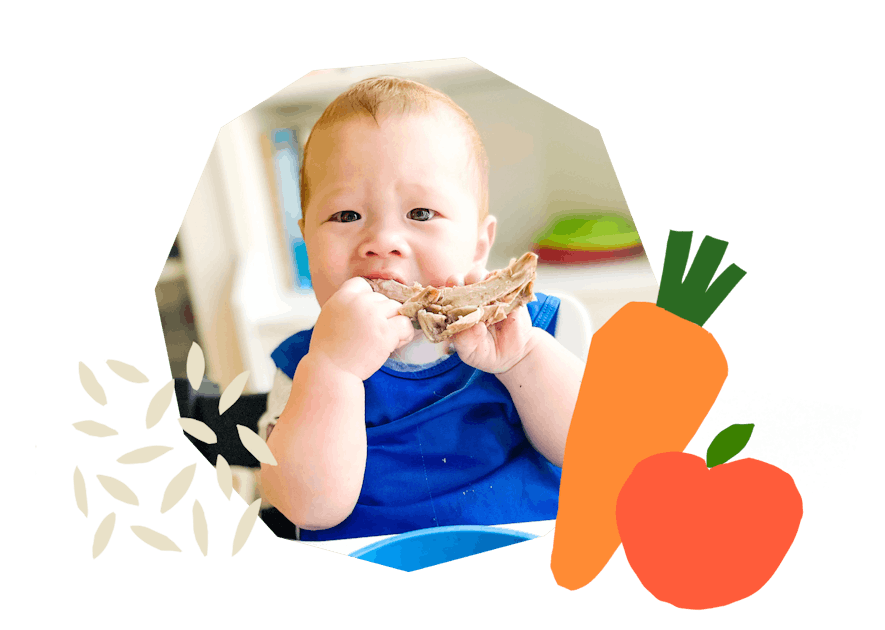
The Program Baby-Led Weaning with Katie Ferraro
A step-by-step digital program for starting solid foods safely and navigating the original 100 FIRST FOODS™ meal plan with baby-led weaning.
 EXPERT-LED, PROVEN APPROACH TO EATING REAL FOOD
EXPERT-LED, PROVEN APPROACH TO EATING REAL FOOD CONCISE VIDEO TRAININGS TO MASTER BABY-LED WEANING
CONCISE VIDEO TRAININGS TO MASTER BABY-LED WEANING 100 FIRST FOODS DAILY MEAL PLAN WITH FOOD PREP VIDEOS
100 FIRST FOODS DAILY MEAL PLAN WITH FOOD PREP VIDEOS
Baby-Led Weaning for Beginners Free Workshop
Is your baby ready to start solid foods, but you’re not sure where to start? Get ready to give your baby a solid foundation to a lifetime of loving real food…even if you’re feeling overwhelmed or confused about this next stage of infant feeding.
Get baby-led weaning recipes and tips delivered to your email inbox.

